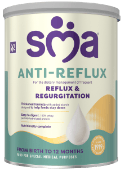How to deal with infant reflux
Overview
-
1 in 2 infants under 3 months of age can experience reflux and baby regurgitation daily1, in the UK this equates to about 200,000 infants each year2
-
Although infant reflux is considered a mild digestive discomfort which will resolve itself in the first year of life3 the NHS continues to experience a high number of parents seeking help from their healthcare professional4,5
-
The cost of infant reflux to the NHS is significant but certain changes in practice may help reduce this cost6,7
What parents of infants with reflux are experiencing
A mum and baby focus group asked how their baby’s feeding issues made them feel*
Question: Which words best describe your feelings as the parent of an infant with reflux?
*Survey carried out by MiMs Learning in preparation of the SMA® Nutrition module about managing infant reflux and parental anxiety 2021
Infant reflux can be extremely distressing for both parents and infants and influences family quality of life.6
The financial impact of infant reflux on the NHS
Medication is not often required for the treatment of infant reflux and unnecessary prescribing of medications like alginates, represents a significant cost to the NHS.
Between 2021-2022, over £6,000,000 was spent on alginates alone7.
UK prescription of Gaviscon Infant from
February 2021 – February 20227:
(~28,947,049 units)
£6,792,857
Implementing the NICE approach to managing infant reflux
For breast-fed infants NICE recommends they are referred for a breastfeeding assessment with a trained individual. If there is no improvement, then an alginate could be trialled for 2 weeks8.
For formula-fed infants, a stepped-care approach is recommended. If after practical feeding advice is given, there is no improvement, then a nutrition before medication approach is recommended8. This approach recommends trialling a thickened formula such as SMA® Anti-Reflux Formula.
Trialling SMA® Anti-Reflux Formula
SMA® Anti- Reflux is a starch thickened formula, the thickened nature of the formula works by reducing infant reflux and subsequent regurgitation, it is suitable from birth until 1 year of age.
Benefits of Starch Thickeners
-
Reducing frequency of regurgitation: Starch-thickened formulas have been shown to significantly reduce the number of daily regurgitation episodes*9
-
Supporting absorption of nutrients: Digestible starch thickeners do not interfere with the availability of calcium, iron and zinc compared to indigestible thickeners, such as Carob bean gum10,11
SMA® Anti-Reflux is the only anti-reflux formula in the UK&I with a unique combination of easily digestible starch and 100% whey, partially hydrolysed protein, to help manage reflux and regurgitation9,12-13
Available on prescription and over the counter.
NICE, The National Institute for Health and Care Excellence
*p<0.0001, compared to a standard formula
® Registered Trademark
-
Vandenplas Y et al. J Pediatr Gastroenterol Nutr 2009; 49: 498-547.
-
Office for National Statistics. Births in England and Wales 2021. Available at https://www.ons.gov.uk/peoplepopulationandcommunity/birthsdeathsandmarriages/livebirths/bulletins/birthsummarytablesenglandandwales/2021#live-births-and-fertility-rates (Accessed October 2023).
-
Van Tilburg MA et al. J Pediatr 2015; 166: 684-689.
-
Leung A and Hon K. Gastroesophageal reflux in children: an updated review. Drugs in Context. 2019. [cited April 13, 2022]. Available from: https://doi.org/10.7573/DIC.212591.
-
National Health Service (NHS). Reflux | Breastfeeding Challenges | Start4LiFE 2021. Available from: https://www.nhs.uk/start4life/baby/feeding-your-baby/breastfeeding/breastfeeding-challenges/reflux/. (Accessed October 2023).
-
Quality of life of infants with functional gastrointestinal disorders, Nestle Nutrition Institute. Available at https://www.nestlenutrition-institute.org/the-nest-46-functional-gastrointestinal-disorders-in-infants/quality-of-life-of-infants-with-functional-gastrointestinal-disorders (Accessed October 2023)
-
Openprescribing. Total prescribing for Gaviscon Infant oral powder sachets across all regional teams in NHS England [Online]. Available at https://openprescribing.net/analyse/#org=regional_team&numIds=0101021B0BEADAJ&denom=nothing&selectedTab=map. (Accessed October 2023).
-
NICE (2015). Gastro-oesophageal reflux disease in children and young people. Available at https://www.nice.org.uk/guidance/ng1. (Accessed: October 2023).
-
Indrio F, et al. Effect of a Partially Hydrolysed Whey Infant Formula Supplemented with Starch and Lactobacillus reuteri DSM 17938 on Regurgitation and Gastric Motility. Nutrients 2017, 9, 1181.
-
D. Bosscher, M. Van Caillie-bertrand & H. Deelstra (2003) Do thickening properties of locust bean gum affect the amount of calcium, iron and zinc available for absorption from infant formula? In vitro studies, International Journal of Food Sciences and Nutrition, 54:4, 261-268.1
-
Bosscher et al. Thickening Infant Formula With Digestible and Indigestible Carbohydrate: Availability of Calcium, Iron, and Zinc In Vitro. Journal of Pediatric Gastroenterology & Nutrition: April 2000 - Volume 30 - Issue 4 - pp 373-378.
-
SMA® Anti-Reflux datacard (2020). Available at https://www.smahcp.co.uk/formula-milk/anti-reflux-formula. (Accessed October 2023).
-
SMA® Anti-Reflux datacard (2020). Available at https://www.smahcp.ie/formula-milk/anti-reflux-formula. (Accessed October 2023).
IMPORTANT NOTICE:
We believe that breastfeeding is the ideal nutritional start for babies as breast milk provides a balanced diet and protection against illness for a baby. We fully support the World Health Organization’s recommendation of exclusive breastfeeding for the first six months of life followed by the introduction of adequate nutritious complementary foods along with sustained breastfeeding up to two years of age. We also recognise that breastfeeding may not be an option due to certain medical conditions. Parents should only feed Infant formula for special medical purposes under supervision of a healthcare professional after full consideration of all feeding options, including breastfeeding. Continued use must be assessed by the healthcare professional in relation to the baby's progress bearing in mind any social and financial implications for the family. Infant formula should always be prepared, used and stored as instructed on the label in order to avoid risks to a baby’s health. This product must be used under medical supervision. SMA® Anti-Reflux is a special formula intended for the dietary management of bottle-fed babies when significant reflux (regurgitation) is a problem. It is suitable as the sole source of nutrition up to 6 months of age, and in conjunction with solid food up to 12 months of age. If the baby’s reflux does not improve within 2 weeks of starting SMA® Anti-Reflux, or if the baby fails to thrive, the family doctor should be consulted.



